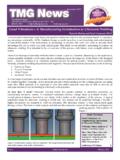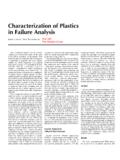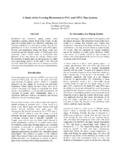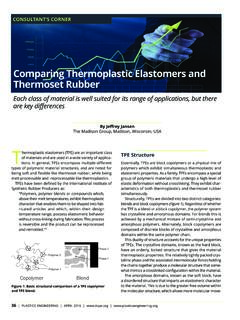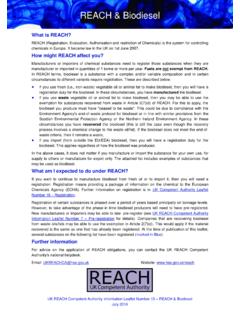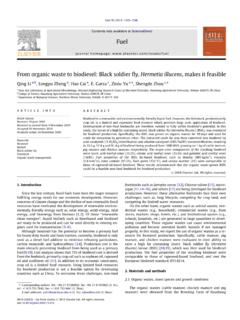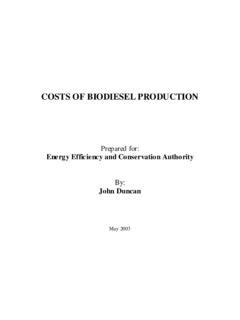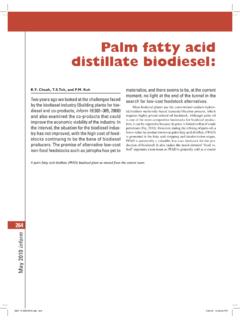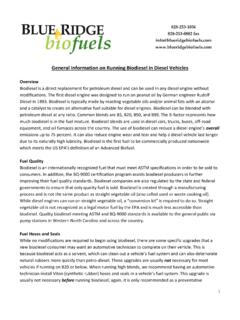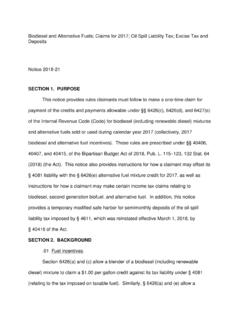Transcription of Effects of Biodiesel on Plastics - madisongroup.com
1 Effects of Biodiesel on Plastics David Grewell, Tong Wang, Melissa Montalbo-Lomboy, Linxing Yao, Iowa State University, Ames, IA Paul Gramann and Javier Cruz, The Madison Group, Madison, WI Abstract Many chemicals have the ability to attack Plastics leading to failure. In some cases, the source of the chemical is not well defined. In this study, the effect of Biodiesel , a fatty acid methyl ester, on various Plastics , namely polyamide 6 (PA 6), polycarbonate (PC), acrylonitrile-butadiene-styrene (ABS) and ABS/PC plastic blends was studied. Various feedstocks of Biodiesel were also studied, including, soy bean oil (new and used), animal fat (tallow), corn oil as well as choice white grease. The Plastics samples were tested following an ASTM standard where a predefined strain is applied to the samples prior to exposure to the solvent ( Biodiesel ).
2 This study has shown that Biodiesel can be incompatible with engineering Plastics , such as PC, ABS and ABS/PC blends. Introduction In the recent decade, there has been a continued rise of biofuel production in the United States due to the fluctuations of petroleum costs and negative impacts of fossil fuels to the environment. This has demanded the creation of a more sustainable energy resource such as bioethanol and Biodiesel . The Biodiesel industry, in particular, has produced more than 1 billion gallons in 2011 [1]. The National Biodiesel Board has noted that it is a key milestone for the industry. As of August 2012, there are about 699 million gallons Biodiesel produced according to the Energy Information Administration [2]. Currently, there are 105 Biodiesel plants in with an annual production capacity of billion gallons.
3 It is expected that these numbers will continue to increase as new feedstocks resources are explored. The use of vegetable oils in diesel engines was considered inadequate due to its high kinematic viscosity, which can lead to engine fuel deposits. Vegetable oils have to be reduced to a lower viscosity before it can be used as a diesel fuel. One of the methods to obtain this is by transesterification. In the presence of a catalyst (acid, base or enzyme), triglycerides in oils reacts with an alcohol (typically methanol is used), to produce Biodiesel or fatty acid methyl esters (FAME) and glycerol. This involves three reversible stepwise chemical reactions that convert triglycerides to diglycerides to monoglycerides, then finally to glycerol. Each step releases one mole of FAME. The transesterification process decreases the viscosity significantly, correspondingly giving the Biodiesel a viscosity that is low enough to be used in diesel engines.
4 Standard #2 diesel fuel is a liquid diesel fuel derived from petroleum. It is mainly composed of saturated hydrocarbons and aromatic hydrocarbons. To be used as substitute for #2 diesel fuel, Biodiesel needs to meet ASTM D6751 and EN14214 before it can be used as a substitute for standard #2 diesel. These standards give detailed requirements ( flash point, water and sediment content, other contaminant levels) that the fuel must meet. Biodiesel fuel is made from a reaction of triacylglycerides and methanol. The resulting Biodiesel is essentially fatty acid methyl esters (FAME), as shown in Figure 1. It is known that many Plastics will have incompatibility issues with ester-based chemicals [3]. The study investigated the compatibility of various Plastics to six biodiesels. formulated from different feedstocks. Chemical Degradation Chemical degradation of plastic by a foreign material involves the reduction in length of the molecular chain and corresponding molecular weight of the polymer.
5 It is generally observed that the longer the molecular chains of the plastic, the more desirable the mechanical properties, as well as other properties [4]. This is primarily due to the entanglement of the long molecular chains. Chemical degradation involves a chemical reaction where the molecule is modified and effectively reduced in length. Environmental Stress Cracking Environmental stress cracking (ESC) involves stress and a foreign chemical synergistically working together to break molecular secondary bonds of the plastic [5]. ESC is different than chemical degradation since it does not reduce the length of the molecules. The chemical penetrates the molecular structure with the assistance of stress and interferes with intermolecular forces allowing for molecular disentanglement to take place. ESC is an accelerated form of brittle plastic creep.
6 It is associated with sustained stress over a period, involves molecular disentanglement and results in the plastic cracking in a brittle mode. The chemical associated with ESC accelerates the molecular disentanglement. Figure 2 shows a typical time to failure for a plastic. As the stress is reduced failure (cracking) takes longer to occur. In this graph two transitions are shown: brittle-to-ductile and ductile-to-brittle failure modes. The effect of a chemical that can cause ESC to occur is to shift this graph to the left, effectively reducing the time to failure at the same stress. Assessment of Chemical Compatibility Experimental data may be found on chemical resistance of some Plastics to a number of biodiesels, however, very little will be found on ESC. To evaluate the ability of a plastic to perform while exposed to a foreign material, appropriate testing should be completed.
7 It is important that the tests be run over a period of time to allow the fluid and application of stress/strain interact with the plastic. As stated above, ESC is essentially an accelerated form of plastic creep in a brittle mode. Following an ASTM standard [6,7,8] one can evaluate the compatibility of a plastic while subjected to stress. effect of Biodiesels on Plastic Test Procedure To analyze several different plastic materials to various formulations of Biodiesel , as well as, standard #2 diesel fuel, ASTM D 543 was used. The plastic samples were placed in a jig that applied a constant strain of over a 10 day period, as shown in Figure 3. Samples were also exposed to the standard diesel and biodiesels at zero applied strain. A strain of is on the higher of strains that are typically used for ESC testing.
8 To ensure a constant exposure of the plastic to the chemical, a cotton gauze was wrapped around a two-inch section of the sample for the chemical to be applied to. Testing was done at ambient conditions. The samples were observed on a daily basis and chemical reapplied as necessary. The samples were analyzed by visually observing cracking. Time for cracking to occur gave a comparative measure of the severity of the chemical. Plastic Materials Analyzed Four different plastic materials were tested. The samples were molded under controlled conditions by Standard Plaque in Melvindale, Michigan. Polyamide 6 (PA6) DSM Alkulon K222-D Natural Unreinforced Polycarbonate (PC) LG-Dow Calibre 301-22 Clear Unreinforced Acrylonitrile-butadiene-styrene (ABS) BASF Terluran GP-22 Natural Unreinforced PC/ABS Sabic Cycoloy CX7240 white Unreinforced Biodiesel Blends Ten Biodiesel samples were obtained from Renewable Energy Group (REG) (Ames, Iowa).
9 The samples were produced using the following feedstocks: used cooking oil, soy, tallow, distiller s corn oil, choice white grease (CWG), and mixed feedstocks1. The Biodiesel samples were analyzed using gas chromatography (GC). Table 1 shows the fatty acid (FA) and FAME composition of the samples. There were too many minor GC peaks to positively identify, thus only the five major peaks were presented. Additionally, tallow Biodiesel have many other minor FAs or GC impurities outside the five major FAs, so the total GC peaks accounted by the five major FAs is low (mid 80%). It also has more unsaponifiable matter, which is reflected by the relatively low total FAME in the sample. Sample #3 Source: Used cooking oil Date: 8/17/2009 Sample #6 Source: Soy Date: 9/11/2012 Sample #7 Source: Mixed feedstock Date: 7/5/2012 Sample #8 Source: Tallow Date: 9/11/2012 Sample #9 Source: Choice white grease (CWG) Date: 8/16/2009 Sample #10 Source: Distillers corn oil Date: 9/11/2012 1 Note, samples 1,2,4,5 were repeats of the other samples, but produced on a different date.
10 Thus, they were not tested. Table 1 FAME and Fatty acid composition of Biodiesel samples Sample Fatty Acid (FA), % 16:0 18:0 18:1 18:3 18:3 3 6 7 8 9 10 FAME, % in sample, as received Total GC peak accounted by the 5 FAs, % 3 6 7 8 9 10 Samples 3, 6, 7, 8, 9, 10 are as follows respectively, used cooking oil, soy, mixed feedstock, tallow, choice white grease, and distillers corn oil. Discussion The results of ESC testing are shown in Table 2. There are several general conclusions that can be made from the tests that were performed. It should be noted that the results are for the specific materials tested and should not specifically be applied to Plastics of the same type. Molecular weight of the plastic is a driver on how well the plastic will perform when a subjected to a chemical and/or stress.
